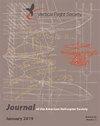利用机载流量传感改进旋翼无人机阵风容忍度
IF 1.4
4区 工程技术
Q2 ENGINEERING, AEROSPACE
引用次数: 0
摘要
本文研究了一种双旋翼加抗转矩前旋翼的双旋翼微型飞行器的抗阵风性能。在闭环反馈系统中实现了一种基于速度反馈和机载流量传感的抗阵风控制器。拴绳实验将车辆安装在6自由度支架上,在合成阵风产生装置前进行,该装置能够提供高达4米/秒的阶跃阵风输入。系统地研究了旋翼机纵向和横向轴上的平面阵风和侧风。俯仰控制(改变机头旋翼转速)和推力矢量控制策略都被评估来抵消纵向轴上的扰动,而旋翼机则使用旋翼机的不同转速来控制侧向阵风。结果表明,推力矢量控制比俯仰控制更有效地减小了阵风产生的位移。使用位置反馈控制器的俯仰控制产生的最大阵风容差为2.8 m/s,持续时间为3 s,而使用流量反馈和位置反馈联合控制器的推力矢量控制能够承受4 m/s的阶跃阵风输入,持续时间为1 s,位移仅为0.01 m。此外,流量反馈比位置反馈更能有效地减小位置误差。该旋翼机还能够减轻2.8米/秒的级阵风,持续时间为3秒,侧风分量与纵轴30度。性能上的差异可以归因于旋翼直升机独特的推力矢量能力。本文章由计算机程序翻译,如有差异,请以英文原文为准。
Improved Gust Tolerance of a Cyclocopter UAV Using Onboard Flow Sensing
This paper describes the gust rejection study of a twin-cyclocopter micro air vehicle with two cyclorotors and an anti-torque nose rotor. A gust rejection controller relying on velocity feedback and onboard flow sensing was implemented in a closed-loop feedback system. Tethered experiments were conducted with the vehicle mounted on a 6-DOF stand in front of a synthetic gust generation device capable of providing up to 4 m/s step gust input. Planar gusts along the longitudinal and lateral axis of the cyclocopter and crosswinds were systematically studied. Both pitch control (varying nose rotor rpm) and thrust vectoring control strategies were evaluated to counteract perturbation along the longitudinal axis, while the cyclocopter used differential rotational speed of the cyclorotors for lateral gusts. Results showed that thrust vectoring was more effective than pitch control in reducing displacement from gust. Pitch control using the position feedback controller resulted in a maximum gust tolerance of 2.8 m/s with a duration of 3 s. while thrust vector control using the combined flow feedback and position feedback controller was able to withstand 4 m/s step gust input with 1 s duration with only 0.01 m displacement. In addition, flow feedback was more effective than position feedback in minimizing position error. The cyclocopter was also able to mitigate step gusts of 2.8 m/s in magnitude and 3 s duration with crosswind components at 30 deg from the longitudinal axis. The difference in performance can be attributed to the cyclocopter's unique thrust vectoring capability.
求助全文
通过发布文献求助,成功后即可免费获取论文全文。
去求助
来源期刊

Journal of the American Helicopter Society
工程技术-工程:宇航
CiteScore
4.10
自引率
33.30%
发文量
36
审稿时长
>12 weeks
期刊介绍:
The Journal of the American Helicopter Society is a peer-reviewed technical journal published quarterly (January, April, July and October) by AHS — The Vertical Flight Society. It is the world''s only scientific journal dedicated to vertical flight technology and is available in print and online.
The Journal publishes original technical papers dealing with theory and practice of vertical flight. The Journal seeks to foster the exchange of significant new ideas and information about helicopters and V/STOL aircraft. The scope of the Journal covers the full range of research, analysis, design, manufacturing, test, operations, and support. A constantly growing list of specialty areas is included within that scope. These range from the classical specialties like aerodynamic, dynamics and structures to more recent priorities such as acoustics, materials and signature reduction and to operational issues such as design criteria, safety and reliability. (Note: semi- and nontechnical articles of more general interest reporting current events or experiences should be sent to the VFS magazine
 求助内容:
求助内容: 应助结果提醒方式:
应助结果提醒方式:


